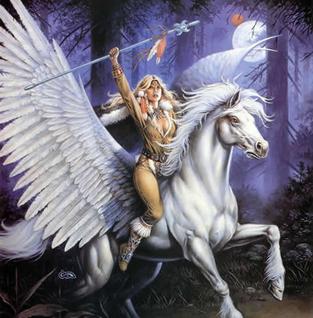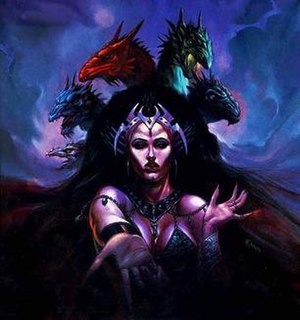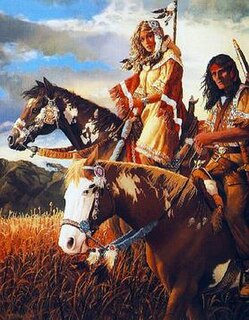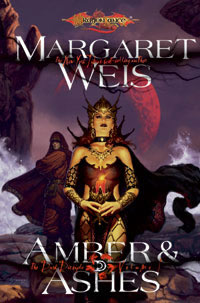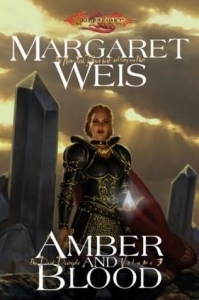The Dragonlance deities, also commonly referred to as gods, are the high powers of the fictional world of Krynn, where the Dragonlance campaign setting takes place. They differ from the gods of other Dungeons & Dragons campaign settings in that the gods themselves do not have d20 mechanics. However, their aspects, the way they manifest into the world, do. The gods of Krynn are formless, and represent a particular aspect of creation. They periodically send messengers, omens, visions, and their own aspects to the world. The gods of Krynn never bring their full essence into the world. [1]

Dragonlance is a shared universe created by Laura and Tracy Hickman, and expanded by Tracy Hickman and Margaret Weis under the direction of TSR, Inc. into a series of fantasy novels. The Hickmans conceived Dragonlance while driving in their car on the way to TSR for a job interview. At TSR Tracy Hickman met Margaret Weis, his future writing partner, and they gathered a group of associates to play the Dungeons & Dragons role-playing game. The adventures during that game inspired a series of gaming modules, a series of novels, licensed products such as board games, and lead miniature figures.

Dungeons & Dragons is a fantasy tabletop role-playing game (RPG) originally designed by Gary Gygax and Dave Arneson. It was first published in 1974 by Tactical Studies Rules, Inc. (TSR). The game has been published by Wizards of the Coast since 1997. It was derived from miniature wargames, with a variation of the 1971 game Chainmail serving as the initial rule system. D&D's publication is commonly recognized as the beginning of modern role-playing games and the role-playing game industry.
The gods of Krynn are very active in the lives of the people of Krynn. They work to maintain the world, but all of them have different ways of going about it. For example, Takhisis, the major goddess of evil, believes in subjugating the world to bring order. Paladine, the major god of good, tries to educate the people to bring about order, and Gilean, the major god of neutrality believes that mortals have to be able to choose their own path to have order. The gods of the three alignments (Good, Evil, and Neutrality) form the Balance of Krynn. [2] Clerics in the Dragonlance setting can serve any of the gods except Lunitari, Nuitari, and Solinari, [3] who grant the arcane magic of wizardry rather than clerical power. [3]
There are two eras in the Dragonlance world when the gods were not active in the world: the majority of the Age of Despair (after the Cataclysm until the War of the Lance); and the early Age of Mortals (before the War of Souls). [4]
The War of Souls is a fictional war set in the popular Dragonlance fictional universe. The War of Souls series follows the heroes of the War of the Lance to fill in many details of the Dungeons & Dragons fantasy role-playing game storyline. Like many Dragonlance stories, can be read as stand alone stories or in series order.
Chaos and the High God
Chaos and the High God are the highest beings in the cosmology of Krynn. They are mysterious but widely credited with a role in the creation of the world. Chaos, originally known as Ionthas, was once the most powerful of the pantheon, second only to the High God, although the High God claimed to be further above the gods than the gods were above the mortals. Ionthas tried to corrupt and control the world; when the gods created the mortal races, Chaos created the animals and as a joke, endowed them with superior attributes than the mortals had: among them long sight, long life, exceptional hearing, powerful magic. The dragons in particular inherited almost all of these traits. Ionthas was eventually banished from Krynn by the High God, where he spent time in his own company and deluded himself into thinking that he was the true High God, that the world should be his. When the god Reorx came looking for a sliver of Chaos to put into the Gray Gem—the equivalent of the clipping of a toenail or a few strands of hair, in Reorx's words—Chaos leapt at the chance and willingly put all of himself into the gem.
The High God created the twenty-one lesser gods to be its servants in the plan for Krynn. When the mortals were created, Ionthas tried to take control of the world and its fate, beginning the All-Saints War as the gods wrestled for the fate of the mortals. One camp, led by Takhisis, held that mortals should be the slaves of the gods and tried to exert her influence to control them. The opposing camp, led by Paladine, said they should do as the High God instructed and guide the mortals, and realize that the mortals had the potential to grow, change and eventually become better and brighter than the gods themselves. This faction wrestled with the evil gods to stop them from gaining control of the mortals. The gods of neutrality took neither side, and did nothing more than tend their responsible areas. Eventually, the High God intervened and declared thus: It is the High God, and they were all nothing compared to the High God. It was pleased with Paladine and his fellows, for they adhered to the spirit as well as the letter of the High God's instructions. It was displeased with Gilean and his camp, for they adhered only to the letter, but it would permit them their seeming neutrality, even though all they did would be to the High God's purpose. And it was mightily displeased with the gods of Evil, who sought to rise above themselves. However, it would permit them their efforts, for they made a balance with the other two, a balance that anchored the world—and the balanced could be changed, but the change must come from within, from the mortals themselves and not be forced upon it by the gods. It stated that the gods of Evil would ignore this and strive to enslave the world anyway, but it warned them that though they would try their mightiest to disrupt the High God's plan, all their efforts would only further it. The High God is virtually unknown to the mortals of Krynn, but Paladine says that the effects of its will are felt throughout the world, in the form of luck, to steer the world in the chosen direction. The High God is feared among all the gods. It seems that to say the High God's name in an oath is the most powerful oath a god could make. After Huma defeated Takhisis he made her swear by that which the Queen held highest, and she swore on the High God. This suggests that even though the evil gods work against the High God's plan, they fear it and respect it. [5]
Gods of Good
The Gods of Good believe that teaching mortals to love order and law is the way to preserve the Balance. Their combined doctrine is encouragement, nurturing, and love. They defend the world and mortals from evil, but usually through mortals themselves. The Gods of Good are led by Paladine until the War of Souls. Afterwards, they unofficially follow Mishakal, but have no true leader. [6] They reside in the Dome of Creation, a plane of light and positive energy. The plane houses the essences of all the Gods of Good except Paladine who is now mortal, and Solinari, who remains closer to the world in his white moon. [7]

In religion, ethics, philosophy, and psychology "good and evil" is a very common dichotomy. In cultures with Manichaean and Abrahamic religious influence, evil is usually perceived as the dualistic antagonistic opposite of good, in which good should prevail and evil should be defeated. In cultures with Buddhist spiritual influence, both good and evil are perceived as part of an antagonistic duality that itself must be overcome through achieving Śūnyatā meaning emptiness in the sense of recognition of good and evil being two opposing principles but not a reality, emptying the duality of them, and achieving a oneness.
Branchala
Branchala, also known as The Bard King, the Song of Life, and the Songmaster, represents the godly power of inspiration. He encourages souls to rise to greater heights of happiness and beauty. He is the patron of music and poetry. He is closely allied with Habbakuk, and their followers often work together. Branchala earliest endeavors made a place of romance and esteem, bringing art and song in Krynn's mortals. The elves hold Branchala in high regard. In addition to his alliance with Habbakuk, Branchala works with Mishakal. He can be at odds with Kiri-Jolith, Majere, and Paladine because of their lawful tendencies and Branchala's chaotic ones. Among the Gods of Neutrality he is closest with Sirrion because of their joint interest in art and creativity. He opposes Chemosh, Hiddukel, and Morgion the most among the Gods of Evil. His celestial symbol is the constellation Harp. [8]
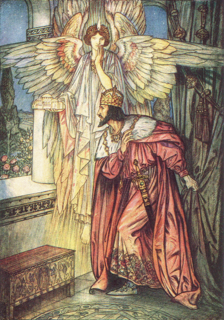
Inspiration is an unconscious burst of creativity in a literary, musical, or other artistic endeavour. The concept has origins in both Hellenism and Hebraism. The Greeks believed that inspiration or "enthusiasm" came from the muses, as well as the gods Apollo and Dionysus. Similarly, in the Ancient Norse religions, inspiration derives from the gods, such as Odin. Inspiration is also a divine matter in Hebrew poetics. In the Book of Amos the prophet speaks of being overwhelmed by God's voice and compelled to speak. In Christianity, inspiration is a gift of the Holy Spirit.
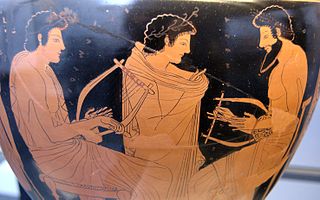
Music is an art form and cultural activity whose medium is sound organized in time. General definitions of music include common elements such as pitch, rhythm, dynamics, and the sonic qualities of timbre and texture. Different styles or types of music may emphasize, de-emphasize or omit some of these elements. Music is performed with a vast range of instruments and vocal techniques ranging from singing to rapping; there are solely instrumental pieces, solely vocal pieces and pieces that combine singing and instruments. The word derives from Greek μουσική . See glossary of musical terminology.

Poetry is a form of literature that uses aesthetic and rhythmic qualities of language—such as phonaesthetics, sound symbolism, and metre—to evoke meanings in addition to, or in place of, the prosaic ostensible meaning.
Habbakuk
Habbakuk, also known as The Fisher King, Skylord, and the Blue Phoenix, represents the godly power of persistence. He believes in the perseverance of the soul and its opposition to adversity for the greater goal.
Habbakuk's interests are generally directed at animals of all kinds. He is the patron of rangers, hunters, and the natural cycle of life and death, abhorring things like undead. He also represents loyalty and obedience to the whole. He promotes persistence of truths that promote good. He has a strong presence in the world through patronage of good druids and rangers. Sailors and explorers also honor him, as he is sometimes called the god of the sea. In times of war and crisis he directs his efforts towards the renewal of life.
Habbakuk's closest ally is Branchala and is also close with Mishakal, Paladine, and Kiri-Jolith. He is closest to Chislev and Sirrion among the Gods of Neutrality for their roles in nature. He opposes Chemosh and Zeboim for their interference in the cycle of life. His celestial symbol is the constellation Phoenix. [9]
Jeff Grubb writes about the origin of Habbakuk:
In the real world, Habakkuk (note the single " b" and the third " k" ) was a prophet in the Bible (one of the " eight minor prophets" ). His book is a collection of oracles delivered against the backdrop of the Babylonian threat to Judah in c.600 B.C. Interestingly enough, the original Habakkuk was a bard, a temple singer. His book was on the subject of why a good god would allow the evil Babylonians to exist and thrive. [10]
Kiri-Jolith
Kiri-Jolith, also known as the "Sword of Justice" and the "Bison of Heaven", represents the godly power of henosis or unity. He encourages the soul to grow as a part of the whole in order to benefit from the strength of brotherhood.
Kiri-Jolith is the patron of soldiers and warriors who fight in order to defeat evil. He promotes courage and justice, and is the spirit of honorable battle. He is not a warlike god, however, but supports war when it is necessary to maintain integrity. He promotes strength of spirit in times of peace. He is the courageous spirit of bonds among mortals. He is the patron of the Knights of Solamnia, and his warrior priests lead the fights against evil armies and advise rulers.
Kiri-Jolith is close with most of the Gods of Good, particularly Paladine and Habbakuk. He has the least in common with Branchala. He is the second most-worshipped god of the minotaurs, who also call him "Emperor".
Kiri-Jolith is closest to Reorx and Shinare among the Gods of Neutrality, and is in opposition with Sargonnas, his opposite in war, who has a more violent approach to battle. He also opposes Hiddukel because of his lies and deceit. His celestial symbol is the constellation Bison's Head. [11]
Kiri-Jolith's name was a partial reference to Joelah of the Books of Chronicles. [10]
Majere
Majere (pronounced mah-JAIR-ee [10] ), also known as Mantis of the Rose, Master of Mind, and the Dreamsender, The Even-Handed God, represents the godly force of discipline. Majere believes the way for the soul to become better is through discipline and hard work.
Majere is seen as distant and separate. He encourages mortals to look within for enlightenment, rather than turn to worldly desires and material goods. He is friend and adviser to Paladine. He has few faithful compared to the other gods, but does have a following of monks. His influence on the world is constant but subtle. He often gives counsel to the other Gods of Light in times of crisis. He is appreciated by all the Gods of Good, advising Paladine, Kiri-Jolith, and Mishakal. He rarely interacts with Branchala or Habbakuk, and counts among the Gods of Neutrality Gilean, Shinare, and Zivilyn his allies. He does not have any specific enemies among the Gods of Evil but responds to evil quickly. His celestial symbol is the constellation Rose. [12]
Mishakal
Mishakal, also known as the Light Bringer, the Healing Hand, and the Blue Lady, represents the godly power of restoration. She embraces the soul's wish to grow and to learn from mistakes. She is the goddess of healing, motherhood, and restoring the lost. She actively works to make things right in the world and tries to rid the world of evil with her compassion.
Mishakal is constantly loving and protecting to the world. Her nature sometimes conflicts with the violent conditions her faithfuls encounter, but she has a wide breadth of worship during times of strife.
Mishakal was the Goddess who restored the knowledge of the true Gods during the War of the Lance. The cleric Goldmoon was given the Blue Crystal Staff to restore the faith of the Gods to the world. The teachings of Mishakal, taken up by Goldmoon, led to the discovery of mysticism when magic was lost after the Chaos War. She is loved by all the Gods of Good, and the Gods of Neutrality all hold her in regard. She is in opposition to every God of Evil for the same reasons she is beloved by the Gods of Good. Every God of Evil harms life in some way, and for that reason Mishakal opposes them all. Her celestial symbol is the constellation Infinity. [13]
Her name was taken from the character of Meshach from the Book of Daniel. [10]
Paladine
Paladine, also known as the Platinum Dragon, the Valiant Warrior, Fizban, and Draco Paladin, represented the godly force of majesty. He sponsors the soul's aspirations to rise to greater heights and to improve itself by following the example of others. He granted divine right to kings and rulers. Paladine sacrificed his godhood after the War of Souls to balance the death of his arch-rival, Takhisis.
Paladine represented the power of redemption and righteousness can have on the world. He exemplified glory and victory. He was one of the first Gods summoned from the Beyond. He was the leader of the Gods of Light until the War of Souls. He furthered the High God's plan among those who follow the ideals of compassion and peace.
Paladine lead the other Gods of Good through his example. Paladine responded to the demands of the Kingpriest, who arrogantly demanded divine power, by casting a fiery mountain upon the world, causing the Cataclysm.
Paladine later took the form of the absent-minded wizard Fizban the Fabulous to aid the Heroes of the Lance. After the heroes ended their quest, he had come to like the name and told Tasslehoff Burrfoot (a kender) that he would then on be called Fizban by Kender.
Paladine was a patriarch of sorts to the Gods of Light. He was advised by Majere and was the partner of Mishakal. Kiri-Jolith and Habbakuk were also close to him. He honored Solinari by taking the form of a white-robed wizard during the War of the Lance. He respected the Gods of Neutrality with no special friends among them and opposed all Gods of Evil. His celestial symbol is the constellation Platinum Dragon. [14]
Paladine's name came from an earlier Draco Paladin and referenced his draconic nature and his patronage of paladins. [10]
Solinari
Solinari, also known as the Mighty Hand, the Ivory Disk, and God's Eye, represents the godly power of magic used for good. He patrons wizards who use their magic with the ideals of compassion, protection, and foresight. As one of the creators of the Laws of High Sorcery he upholds them vigorously. At one point he was the divine power of vigilance, but when he and his cousins in magic abandon the godly planes to be closer to the world he becomes less focused on the Progression of Souls. Solinari guides the souls of good wizards to the Beyond. At one point he dwells in the Dome of Creation but chooses to represent himself in the white moon of Krynn in order to watch over and protect magic. He promotes using magic for the good of all the world. He is friendly with Majere, Habbakuk, Branchala, and Mishakal. He is saddened at Paladine's downfall and offered him his protection, which Paladine, called Valthonis, refused. His relations with the other Gods is minimal, aside from the other Gods of Magic, Lunitari and Nuitari, whom he is especially close to and is also often seen with them among meetings of the gods. His celestial symbol is the silver moon, Solinari. [15]
Gods of Neutrality
The Gods of Neutrality believe that mortals should exist in harmony with the world and make their own moral and faith related decisions. That makes them both a distant group of gods and an involved one at the same time. They promote elemental and conceptual truths as principles alone rather than tools towards an end. They have a strong presence in their particular domains, and keep the world from being in a constant state of conflict between Good and Evil. [16] The Gods of Neutrality reside in the Hidden Vale, with the exception of Lunitari, who resides in the red moon of Krynn to be closer to her wizards. It is a place of both shadow and light which meld together in perfection. [17]
Chislev
Chislev, also known as the Beast, Wild One, and World Mother, represents the godly force of instinct. She believes the soul grows by releasing thought and instinct, and giving in to primal urges. She is the power of the natural world and all things wild. She is at one with Krynn, and extends her wrath to those that abuse the earth. Chislev is wracked with pain and suffering during times of war, and works in the current world to heal the wounds done to it. She is the partner of Zivilyn, and maintains friendship with Sirrion. She conflicts with Shinare and Reorx. Gilean grants Chislev knowledge but he is at times overly intelligent for her. Chislev is regarded among all the Gods of Good, and opposes Morgion among the Gods of Evil in particular. Her celestial symbol is the planet Chislev. [18]
Gilean
Gilean, also known as the Book, the Sage, and the Gray Voyager, represents the godly force of knowledge. He supports the growth of the soul through attaining knowledge and experience. He is the holder of the Tobril, which contains the divine plan of the High God for the world. He is the patron of sages, librarians, and scholars. He is the leader of the Gods of Balance. He supports free will and individual choice for all individuals of Krynn. He is one of the first gods to be called out of the Beyond and is on equal power with Takhisis and Paladine. A legend of him states that the High God commanded Gilean to ensure his own existence by raising the soul of a mortal scholar who would one day become him, in an ontological paradox of sorts. That scholar is most likely Astinus, who watches over the Great Library of Palanthas and scribes all history as it happens until the Chaos War. Gilean is a mediator between the Gods of Good and Evil, siding against the faction that threatens the Balance. All of the Gods of Neutrality look to him for help and advice, and the Gods of Light often do the same in hopes he will side with them. The Gods of Evil manipulate situations to present Gilean with a case where he can only side with them, such as in the Chaos War where Takhisis forces Gilean to side with her Dark Knights, as they are the only chance that mortals can stand against Chaos. His celestial symbol is the constellation Book of Souls. [19]
Lunitari
Lunitari, also known as the Veiled Maiden, Maid of Illusion, and Night Candle, represents the power of magic used for neutrality. She supports wizards who use magic in the name of balance, freedom, and curiosity. She seeks to preserve the balance of good and evil in magic. She was once the divine force of mystery, but she removed herself from the Hidden Vale and joined her cousins Solinari and Nuitari in order to give magic her closer attention. Her focus instead became the mystery of magic. She is said to have come fully born from the thoughts of her father Gilean. She resides in and represents herself through the red moon of Krynn. She tells to her faithful the secrets and discoveries of magic. She is close to Reorx, who sometimes helps her in forging magical artifacts. She, along with Reorx, conspires to trap Chaos in the Graygem, which has led the other Gods of Neutrality to distrust her. She rarely interacts with the Gods of Good and Evil, except for her cousins Solinari and Nuitari, whom she is especially close to, almost always being with them at the meetings of the gods. Her celestial symbol is the red moon, Lunitari. [20]
Reorx
Reorx, also known as the Forge, the World Smith, and Tamer of Chaos, represents the godly force of creation. He desires for souls to grow through crafting and gaining skill. He is the patron of dwarves and gnomes, but also of all craftsmen. He is also followed by gamblers and rogues because they rely on their own talents to change the course of an event. He respects and encourages the power of mortals to shape, build, and produce. Reorx often takes the mortal form of a handsomely dressed dwarf named Dougan Redhammer. Reorx, at the behest of the High God, created the world of Krynn from the raw energies of Chaos. He unknowingly encases Chaos into the Graygem when he sought a bit of the essence of the higher deity to anchor the balance in the world, which later has dire repercussions on the world, releasing an aspect of hatred and destruction upon Ansalon, causing the Chaos War. He is a much loved deity; he works with Shinare and Gilean, and is respected by Sargonnas and Kiri-Jolith for his power of smithing mighty weapons. Zeboim is known to go to Reorx to better understand the workings of ships and the like, so that she can better destroy them. The dwarves hold that Reorx created them as his chosen. His creation of the Grey Gem, and it is resulting inhabiting by Chaos, would eventually result in the creation of both Gnomes and Kender when the energies of Chaos transformed an army of dwarves into Gnomes, and an army of Elves into Kender during the last battles of the war against the warlord Gargath. His celestial symbol is the red star Reorx. [21]
Shinare
Shinare, also known as Winged Victory, the Silver Mistress, and Walking Liberty, represents the godly force of interaction. Those who follow Shinare grow by communicating with other people. She oversees all oaths, negotiations, and partnerships. She promotes the advancement of the world through enterprise. She patrons merchants, without regard to motivation so long as business is done fairly. With that principle in mind, she does not condemn slavery or mercenary activity. Things like theft and cheating, however, she opposes as they impair the principles of interaction. She secretly influenced the development of steel as the principle currency of Ansalon, and has recently become a major influence in the nation of Solamnia. Shinare is partnered with Sirrion, whom she sometimes clashes with because of his chaotic tendencies. She works with Reorx as well, but has only basic, polite relationships with the other Gods of Neutrality. She is closest to Kiri-Jolith and Majere among the Gods of Light because of her belief in honesty and truth, and directly opposes Hiddukel among the Gods of Evil because of his lies and cheating. Her celestial symbol is the planet Shinare. [22]
Sirrion
Sirrion, also known as the Flowing Flame, the Alchemist, and the Firemaster, represents the godly force of transformation. He promotes the soul to give in to passion and creativity to grow and change. He represents fire, because it is the element that brings change and growth, and it represents the creativity of artists and alchemists. Sirrion is chaotic, but does not condone random destruction; instead, change should produce something new. He is the patron of art and alchemy. Legend holds that he created his partner Shinare from grand metals, and that he gave fire to Reorx for the creation of the world. In truth, his responsibility was equal to the other gods. He is the companion of Shinare, although being her complete opposite; however, his passion with her progressive spirit can create much in the world. Sirrion works with Reorx and Chislev, but does not often work with Zivilyn or Gilean. Sirrion is close to Branchala and Habbakuk among the Gods of Light, and opposes Sargonnas among the Gods of Evil, for Sargonnas directs flame into the spirit of wrath and revenge. His celestial symbol is the planet Sirrion. [23]
Zivilyn
Zivilyn, also known as the World Tree, Wise One, and the Tree of Life, represents the godly force of wisdom. He encourages the soul to grow by achieving enlightenment and wisdom. Zivilyn's influence extends to all realms and to all times. He promotes understanding and spiritual awareness. Zivilyn gives counsel to Gilean, bringing wisdom to Chislev as well. Zivilyn, despite his extensive knowledge of all times and places of Krynn, cannot foresee Takhisis stealing the world away during the War of Souls. Zivilyn is respected by all Gods, and never chooses sides in a fight or disagreement. He is closest to Gilean and is the partner of Chislev, and has much in common with Majere and Hiddukel because of their understandings of the power of wisdom and awareness, respectively. Zivilyn does not allow the forces of compassion or corruption to influence him. His celestial symbol is the planet Zivilyn. [24]
Gods of Evil
The Gods of Evil believe that they should direct the fate of mortals. They will willingly turn on one another if necessary. With Takhisis, their former leader, dead, they have begun fighting among one another more than ever before. None of the Gods of Evil have yet to attain the same amount of power Takhisis did, although one of them may take that position soon. [25] The Gods of Evil reside in the Abyss, the source of negative energy, ending light and creation. There, the various fiends conspire, and their masters, the Gods of Evil, oversee the forces of wickedness and corruption. All the Gods of Evil reside here, with the exception of Nuitari, who houses his essence in the black moon of Krynn, and Takhisis, who has been slain and no longer possesses divine essence. [7]
Chemosh
Chemosh, also known as the Lord of Bones, Lifebane, and the Black Goat, represents the godly force of fatalism. He encourages souls to give up to destiny and fate. Chemosh disdains life, feeling that it is wasted on the people of Krynn. He prefers to promise "immortality" by making souls into undead rather than letting them pass into the afterlife. Chemosh gains power as people surrender their free will to him. Chemosh sits in the Hall of Soul's Passing and watches the progression of souls into the afterlife, where he attempts to lure souls into becoming undead. Chemosh is the direct opposite of Mishakal as she promotes life and hope. He is the foe of all of the Gods of Good, and among the Gods of Neutrality is in opposition to Chislev, for disrupting the natural order of life, and Sirrion, for suppressing hope and creativity. He has few allies but sometimes works with Hiddukel and Morgion due to the nature of his schemes. His celestial symbol is the constellation Goat's Skull. [26]
Hiddukel
Hiddukel, also known as the Prince of Lies, the Betrayer, and the Broken Scales, represents the godly force of exploitation. He influences souls to use every encounter with another person to their advantage. He captures souls who are desiring or despairing to use the misfortune of others to their profit. He is ultimately selfish and cares for no one but himself, and passes that attitude on to his mortal followers. Hiddukel constantly attempts to make deals with the other gods, and his lies lead mortals to carry out evil in the world. He is impressed and surprised at the deception of Takhisis in stealing the world from the other Gods. He can call upon nearly all of the Gods of Evil for aid because of his dealing with them and his ability to divert their attention from him if they begin to suspect him. All of the Gods of Neutrality - especially Shinare, because of her promoting of fairness and honesty - oppose him. Reorx as well dislikes him because Hiddukel tricked him into forging the Graygem. Majere and Branchala among the Gods of Good are his enemies, as the powers of discipline and positive interaction respectively. His celestial symbol is the constellation Broken Scale. [27]
Morgion
Morgion, also known as the Black Wind, Master of the Bronze Tower, and the Rat King, represents the godly force of decay. He urges souls to break down their complexities to attain their most basic form. He believes mortals should leave Krynn with nothing but what they came in with. Morgion is the god of diseases and of the ultimate decay of all things, from individuals to nations. Morgion succeeds in the suffering of Krynn. Morgion opposes things like a healthy, wholesome life or a quick, painless death. He believes that the strong survive, and to survive one must suffer. Morgion remains isolated from the other gods and tries to infect the world with plague and horror. He seeks to make Krynn endure as much pain as possible. He opposes Mishakal, Majere, and Habbakuk especially among the Gods of Good, all of whom oppose him. Chislev opposes him for seeking to degrade life, and Sirrion is against him because of Morgion's constant gloom. Shinare and Reorx oppose his goals as well. He interacts little with the other Gods of Evil, brooding in the Bronze Tower at the edge of the Abyss. His celestial symbol is the constellation Diseased Hood. [28]
Nuitari
Nuitari, also known as the Devouring Dark, Nightreaver, and Ungod, represents the power of magic used for evil. He is the patron of wizards who use magic for greed, revenge, hatred, and ambition. He uses the laws of High Sorcery, but only in an attempt to strengthen his own power. He was once representative of the godly force of ambition, but he left the Abyss and housed his essence in the black moon of Krynn. He moved to the black moon when it became apparent to him that magic needed to be brought under control, to prevent it from falling into the hands of wild mages. His focus now is on the Black Robed wizards, overseeing them as they go through their lives. Nuitari is the son of Takhisis and Sargonnas. He, for the most part, loathes his fellow Gods of Evil, and especially detests Takhisis for directing arcane power into the Gray Robed Knights of Takhisis. The only Gods Nuitari regularly interacts with are his cousins Solinari and Lunitari, whom he is especially close to. They are always seen together at meetings among the Gods and promote allegiance to magic first over the forces of good and evil and law and chaos. His celestial symbol is the black moon, Nuitari. [29]
Sargonnas
Sargonnas, also known as the Red Condor, the Firebringer, and the Bull God, represents the godly force of wrath. He orders souls to seek revenge on anything that does them wrong or takes power from them. He is the master of vengeance, wars fought for passion, anger, volcanoes, birds of prey and broken promises. His followers are focused in the use of discipline and order for their pursuits. He is the favorite god of minotaurs, who claim him to be the supreme deity and name him Sargas. Sargonnas favors the minotaurs in turn. Sargonnas is the consort to Takhisis, despite having an uneasy partnership with her; he can ally with her or oppose her to further his own goals. With Takhisis gone and his followers flourishing, Sargonnas is a powerful god in the current time of Krynn. Sargonnas has no real allies. He conflicts with his child Nuitari, and distrusts Chemosh, Morgion, and Hiddukel. He does, however, ally occasionally with Zeboim, because his minotaurs are a seafaring people, and they often honor her. Kiri-Jolith and Paladine are his enemies among the Gods of Good, although each side has a grudging respect for the other. His celestial symbol is the constellation Condor. Sargonnas is known to appear in several forms: His most favored form is a minotaur with jet black or blood red fur, massive horns and blazing eyes, but he can also appear as a minotaur made of magma or a monstrous condor. Minotaurs claim that five is Sargonnas's favored number. [30]
Takhisis
Takhisis, also known as the Queen of Darkness, the Five-Headed Dragon, The Dragon of Many Colors and None, The Temptress, and the Dark Warrior, represents the godly force of control. She brings souls under her will and encourages them to grow according to her plans for conquest. She orders souls to surrender to dominance and give way to those who are stronger. She likewise orders souls to dominate others. She is the highest power among the Gods of Evil and believes that it is her right to one day dominate the entire world. Takhisis is one of the first gods, called along with Paladine. She controls the chromatic dragons and uses them for her conquests, but is always beaten back by the forces of good, evidenced by events like her defeat by Huma Dragonbane with his dragonlance. She launches the War of the Lance on Ansalon but is beaten by the Heroes of the Lance in the end. Her last great scheme, the theft of the world from the other gods, ends in failure for her as she is stripped of her godhood and slain by the elf Silvanoshei. Her celestial symbol is the constellation Five-Headed Dragon. [31] Takhisis most often takes the form of a five-headed dragon, each head being the colour of one of the evil dragons (red, blue, green, black, and white). [32]
Zeboim
Zeboim, also known as the Sea Witch, the Darkling Sea, and the Dragon Turtle, represents the godly force of strife. She encourages souls to give into their urges and release their anger. She is the unpredictable and embodies storm and raging sea, which is the element she commands over. Her attitude constantly changes, going from calm to raging in a minute. She wants souls to continually cause anguish and anger, so that they remain active and vital, instead of becoming predictable and stagnant. Sailors and mariners try to calm her during voyages so that she does not make trouble for their vessel. Zeboim is the daughter of Takhisis and Sargonnas. She mothers, through one of her aspects, the founder of the Knights of Takhisis Ariakan, the son of Ariakas. She loves him dearly and when he is killed she damns his slayer Ausric Krell to become a death knight and traps him on an island. She dislikes her mother and father, along with Chemosh, though she works with both her parents on occasion. She ignores Morgion and Nuitari and works with Hiddukel well. She hates or works against the Gods of Neutrality and has a special dislike for Habbakuk, who she sees as her true foe because of his power of the sea. Her celestial symbol is the constellation Dragon Turtle. [33]






